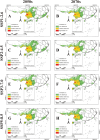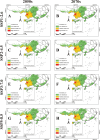Assessing the Potential Distribution of Pseudoechthistatus (Coleoptera: Cerambycidae) in China Under Climate Change Using Species Distribution Models
- PMID: 40230865
- PMCID: PMC11995185
- DOI: 10.1002/ece3.71303
Assessing the Potential Distribution of Pseudoechthistatus (Coleoptera: Cerambycidae) in China Under Climate Change Using Species Distribution Models
Abstract
Climate change will lead to changes in biological ecosystems, which may affect the geographic distribution of Pseudoechthistatus and thus alter the extent and spatial pattern of its habitat. Pseudoechthistatus plays an important role in biodiversity and has significant ecological value. This study utilized an optimized MaxEnt model to predict the predicted distribution of Pseudoechthistatus in China for the current and future (2050s and 2070s). The results show that the MaxEnt model has high prediction accuracy with AUC values higher than 0.97 for both training and testing. The most influential factors contributing to the distribution of Pseudoechthistatus were temperature seasonality (Bio4) and isothermality (Bio3), accounting for 38.8% and 28.2%, respectively. Furthermore, southern China remains a region of high suitability for Pseudoechthistatus species diversity. However, the Beijing climate center climate system model (BCC-CSM2-MR) predicts a decrease in suitable areas for Pseudoechthistatus, while the model for interdisciplinary research on climate (MIROC6) predicts an increase in medium and low suitable areas for Pseudoechthistatus. Additionally, future climate change will significantly alter its distribution pattern, with Pseudoechthistatus predicted to decrease its suitable area by 6.64%-28.01% under the BCC-CSM2-MR model and increase its suitable area by 6.14%-18.61% under the MIROC6 model. The results show that the MaxEnt model can improve the understanding of the geographical distribution of Pseudoechthistatus in the context of climate change and provide a scientific basis for the identification of potentially suitable habitats and the development of stable suitable areas for conservation.
Keywords: MaxEnt; Pseudoechthistatus; biodiversity conservation; climate change; habitat suitability.
© 2025 The Author(s). Ecology and Evolution published by British Ecological Society and John Wiley & Sons Ltd.
Conflict of interest statement
The authors declare no conflicts of interest.
Figures







Similar articles
-
Simulation of the potential distribution of rare and endangered Satyrium species in China under climate change.Ecol Evol. 2022 Jul 11;12(7):e9054. doi: 10.1002/ece3.9054. eCollection 2022 Jul. Ecol Evol. 2022. PMID: 35845387 Free PMC article.
-
Potential Distribution Prediction of Terminalia chebula Retz. in China Under Current and Future Climate Scenarios.Ecol Evol. 2025 Jan 28;15(2):e70908. doi: 10.1002/ece3.70908. eCollection 2025 Feb. Ecol Evol. 2025. PMID: 39896773 Free PMC article.
-
Predicting the potential distribution range of Batocera horsfieldi under CMIP6 climate change using the MaxEnt model.J Econ Entomol. 2024 Feb 12;117(1):187-198. doi: 10.1093/jee/toad209. J Econ Entomol. 2024. PMID: 38007398
-
Predicting the potential global distribution of Sapindus mukorossi under climate change based on MaxEnt modelling.Environ Sci Pollut Res Int. 2022 Mar;29(15):21751-21768. doi: 10.1007/s11356-021-17294-9. Epub 2021 Nov 12. Environ Sci Pollut Res Int. 2022. PMID: 34773237
-
The current distribution of tick species in Inner Mongolia and inferring potential suitability areas for dominant tick species based on the MaxEnt model.Parasit Vectors. 2023 Aug 16;16(1):286. doi: 10.1186/s13071-023-05870-6. Parasit Vectors. 2023. PMID: 37587525 Free PMC article. Review.
Cited by
-
The Ecological Risks and Invasive Potential of Introduced Ornamental Plants in China.Plants (Basel). 2025 Apr 30;14(9):1361. doi: 10.3390/plants14091361. Plants (Basel). 2025. PMID: 40364392 Free PMC article.
References
-
- Dawson, T. P. , Jackson S. T., House J. I., Prentice I. C., and Mace G. M.. 2011. “Beyond Predictions: Biodiversity Conservation in a Changing Climate.” Science 332: 53–58. - PubMed
LinkOut - more resources
Full Text Sources

